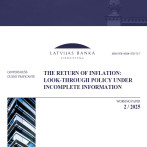Energy resource prices drive up producer prices
Producer prices in January 2012 rose 1.8%, primarily driven up by the appreciating energy resources in the global market. The global food price fluctuations in January of this year were smaller than a year ago and they had a lesser impact on producer price rises.
Oil product prices are still affected by the political turmoil in the Middle East oil producer nations and the situation is exacerbated by the issues regarding the possibilities of increasing refinement capacities unresolved by governments. The oil price dynamics in January had a direct impact primarily on energy resource producer prices in Latvia and an indirect impact also on the costs of all other branches depending on what proportion of the costs is accounted for by the cost of the consumed energy. In January 2012, the greatest month-on-month rises were observed in the producer prices in electrical power, gas supply, heating supply and air conditioning (5.3% month-on-month and 18% year-on-year). Given that this industrial branch primarily works for the domestic market, it also determined the widening difference between the annual rises in the producer price index for the production sold domestically and that exported.
In manufacturing, the producer prices for the production sold domestically and production exported grew at a similar rate (0.5% and 0.4% month-on-month respectively) and overall did not leave the impression that radically different competition conditions were arising in regard to costs. Albeit the impact of the fluctuating energy resource prices and, to a lesser extent, the fluctuations in the global prices of other raw materials, e.g., base metals and wood pulp (in January they were negligible in many categories of goods) contributed to this rise, the other costs characteristic of this assortment of production had a substantial influence on the producer price dynamics. Thus the monthly changes in the prices of production sold domestically fluctuated from -2.2% in the manufacturing of rubber and plastic products to +1.3% in the production of wearing apparel, but the range of price changes in the exported production was more flexible: from -8.6% in the reproduction of recordings and printing and publishing and -4.7% in the repairs and installation of equipment and appliances to +3.5% in the production of equipment, appliances, and machinery not classified elsewhere.
Since after the short-lived drop in oil prices observed in the second part of January, prices have resumed climbing already in February, it is possible that the prices of natural gas and thermal energy will be impacted in Latvia after a few months, because the prices of these energy resources delivered to consumers are substantially impacted by the nine-month fluctuations in the price of mazut in the global market. Meanwhile, no rapid rise in other costs and their negative impact both on consumer prices and the competitiveness of exporting businesses is expected. According to the latest confidence data from surveys of manufacturers, the percentage of those manufacturing enterprises is rising which expect a rise in employment in the next few months. Yet this trend is not long-lived, it is not characteristic of all manufacturing branches and it does not give rise to any worry that a positive gap may form between the rate of salary growth and productivity.
Textual error
«… …»






